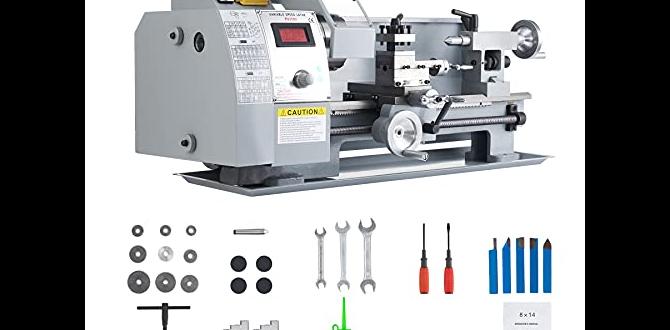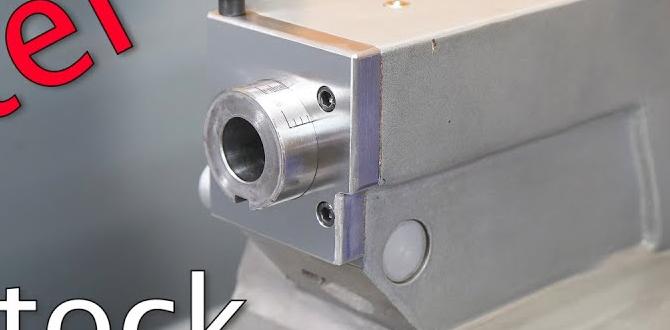1/8″ carbide end mills with low runout are crucial for precise cuts in plastics and soft metals, especially for hobbyists aiming for clean, wobble-free results. Choosing the right one prevents tool chatter, improves surface finish, and extends tool life, making your machining projects much easier and more professional.
The tiny wobble, or runout, in a milling tool can turn a simple job into a real headache. For us hobbyists and budding machinists, especially when working with materials like polycarbonate or softer metals, a precise cut is key. That 1/8″ carbide end mill is a go-to tool, but if it wobbles even a little, you’re going to see it on your workpiece. We’re talking about rough edges, inaccurate dimensions, and a lot of frustration. But don’t worry, we’re going to dive into what makes a good 1/8″ carbide end mill essential, focusing on that magical “low runout” factor. By the end of this, you’ll know exactly what to look for to get those clean, professional cuts every time.
Why “Low Runout” Matters for Your 1/8″ Carbide End Mill
When we talk about runout, we’re basically describing how much an end mill’s cutting edge deviates from a perfect circle as it spins. Think of it like a wobbly bicycle wheel. The tighter the wheel is centered, the smoother the ride. The same applies to your milling machine.
For a 1/8″ carbide end mill, this is paramount. This small diameter means the cutting edges are working with very fine tolerances. If there’s significant runout, that tiny wobble amplifies.
- Surface Finish: High runout leads to chatter marks and a rough surface. Imagine trying to shave with a bent razor – not a clean result! Low runout gives you that smooth, almost polished finish right off the mill.
- Dimensional Accuracy: If your tool is wobbling, it’s not cutting a consistent diameter. Your carefully planned part might end up slightly oversized or undersized, ruining the precision you need.
- Tool Life: Chatter and uneven cutting forces put extra stress on the carbide. This can lead to premature chipping or breakage of the cutting edge, dramatically shortening the life of your expensive end mill.
- Cutting Forces: A tool with high runout vibrates, leading to uneven cutting forces. This can cause the workpiece to vibrate, make the machine harder to control, and even damage your spindle bearings over time.
- Material Specifics: When working with materials like polycarbonate, acrylics, or even softer aluminum alloys, you need a clean cut to avoid melting or chipping. Low runout ensures the tool engages the material cleanly.
A standard length 1/8″ shank end mill designed for low runout essentially means the manufacturer has put extra effort into ensuring the shank (the part that goes into the collet or tool holder) and the cutting flutes are perfectly aligned. This precision is what separates a good tool from a great one, especially for tight tolerances.
Understanding 1/8″ Carbide End Mills
Carbide end mills are made from tungsten carbide, an incredibly hard and wear-resistant material. This makes them ideal for machining tougher materials and for applications where you need a long-lasting tool. A 1/8″ end mill is small, making it perfect for intricate details, profiling, slotting, and general-purpose milling on smaller parts or when working with smaller CNC machines or manual mills.
When you’re looking for an 1/8″ carbide end mill, several factors come into play, but for beginner-friendly, reliable results, “low runout” should be at the top of your list.
Types of 1/8″ Carbide End Mills
While all 1/8″ end mills have the same diameter, they can vary in design for specific tasks:
- 2-Flute: These are excellent for plastics, composites, and softer metals like aluminum. The fewer flutes provide better chip evacuation, preventing melting and clogging.
- 4-Flute: Generally better for harder metals like steel, as they offer a better surface finish with more cutting edges engaging the material at once. For softer materials like polycarbonate, they can sometimes be too aggressive and lead to melting if not managed carefully with feed rates and coolant.
- Square End Mills: The most common type, creating sharp 90-degree corners.
- Ball End Mills: Feature a rounded tip, ideal for creating contoured surfaces, fillets, and 3D carvings.
- Slotting End Mills (or Slitting Saws): Thinner and designed for cutting deep, narrow slots.
For most beginner “how-to” projects involving materials like polycarbonate, a 2-flute carbide end mill is often the recommended choice due to its superior chip clearance.
What “Standard Length” Means
“Standard length” for an end mill typically refers to the overall length and the length of the cutting flute (the part with the helical grooves). While there are often extended reach versions, a standard length end mill is generally more rigid. For rigidity and to minimize vibration, especially with such a small diameter tool, standard length is usually preferred unless you specifically need extra reach. A shorter flute length on a standard overall length tool also adds rigidity.
What is “Low Runout” and Why is it Crucial?
Runout, in the context of machining, refers to the deviation from perfect concentricity and alignment of the cutting tool within its holder or collet. For an end mill, it’s the wobble or eccentricity that occurs when the tool rotates.
Imagine you’re trying to draw a perfect circle with a pencil that’s not held perfectly straight – the circle will be uneven. When your 1/8″ end mill spins, if it’s not perfectly centered in the collet, it will wobble. This wobble is the runout.
Total Indicator Runout (TIR): Manufacturers often specify the TIR of their tools. This is the total reading on a dial indicator as the tool is rotated. For precision tooling, TIR much less than 0.001″ (1 mil) is considered good, and striving for even tighter tolerances (0.0005″ or less) is key for critical applications. For a 1/8″ end mill, even a few tenths of a thousandth can make a difference.
Collet Runout: It’s not just the end mill itself; the collet and the spindle also contribute to the overall runout. A high-quality collet, especially one designed for precision work (like ER-style collets), is essential. A common goal for a good setup is to achieve a combined runout of less than 0.0005″ at the cutting edge.
A 1/8″ carbide end mill that is manufactured with “low runout” means that the manufacturer has taken specific steps to ensure the shank is perfectly concentric with the cutting flutes, and that the tool itself is balanced and precisely ground. This is usually achieved through tighter manufacturing tolerances and careful quality control.
Impact of High Runout on Your Workpiece
Jagged Edges: The tool effectively “skips” on the material, creating a rough, uneven edge instead of a clean cut.
Inaccurate Dimensions: If you’re trying to mill a slot to exactly 0.125″, runout means the actual cutting width will vary.
Surface Marks: Visible arcs or waves on the milled surface.
Increased Heat: Uneven engagement of the cutting edges can lead to localized overheating, especially in plastics.
Choosing the Right 1/8″ Carbide End Mill for Your Needs
When you’re at the store or browsing online, what should you be looking for?
Key Specifications to Consider:
Material: As mentioned, carbide is for hardness and wear resistance.
Number of Flutes: For polycarbonate and soft plastics, 2 flutes are generally best, followed by 3. Avoid 4 flutes for these materials unless you have excellent cooling and very high spindle speeds with precise control.
Coating: While often unnecessary for soft plastics, coatings like TiN (Titanium Nitride) or AlTiN (Aluminum Titanium Nitride) can improve lubricity and wear resistance in harder materials. For polycarbonate, uncoated or a plain carbide finish is often best to prevent material buildup.
Helix Angle: A higher helix angle (e.g., 35-45 degrees) aids in chip evacuation and can provide a smoother cut in softer materials. A standard 30-degree helix is versatile. Very low helix angles (or straight flute) are generally for specific applications and can be prone to clogging.
Shank Type: Typically a straight shank for fitting into collets or tool holders. Ensure it matches your machine’s clamping system (e.g., 1/8″ shank diameter).
Brand and Quality: While budget tools can work, investing in a reputable brand known for precision manufacturing significantly increases your chances of getting a “low runout” tool right out of the package.
For Polycarbonate and Similar Plastics:
When machining polycarbonate or other clear plastics, the goal is to create a clean, chip-free cut that doesn’t melt or craze the material.
2 Flutes: Essential for good chip evacuation.
Sharp Edges: High-quality carbide with a fine grain structure is beneficial.
Uncoated or Polished Finish: Helps prevent plastic from sticking to the cutting edge. Some specialized “plastic” or “plastic-specific” end mills have geometries designed to shear material cleanly.
Low Runout: Absolutely critical. Wobble will cause breakage and rough cuts.
For Softer Metals (Aluminum, Brass):
Similar requirements to plastics, but you might be able to use 3 or even 4 flutes if your machine can handle the chip load and you have a good coolant/lubrication strategy.
2-3 Flutes: Still generally preferred for better chip clearing.
Sharpness: Crucial for preventing material buildup and chatter.
Low Runout: Important for consistent depth of cut and smooth finish.
Achieving Low Runout in Your Machining Setup
It’s not just about the tool; your entire setup contributes to the overall runout.
The Collet System
For 1/8″ carbide end mills, a precision collet system is almost mandatory.
ER Collets: These are the most common and a good choice for hobbyist CNC machines and milling machines. ER16 or ER20 collet chucks are typical.
Quality Matters: Cheap, unhardened collets can introduce significant runout. Invest in a set of quality ER collets from a reputable manufacturer.
Proper Usage:
Always use the correct size collet for your tool shank. For an 1/8″ end mill, you’ll need an ER collet that specifically grips 1/8″ (or a range that includes 1/8″, like 1/8″ to 3mm, or 1/8″ to 1/4″).
Ensure the collet and the inside of the collet nut are clean and free of debris before inserting the tool.
Tighten the collet nut securely using the appropriate wrench, but do not overtighten, as this can damage the collet.
The Spindle
The spindle motor on your milling machine is the heart of the operation.
Spindle Bearings: Worn spindle bearings are a major source of runout and vibration. If your machine is older or has seen heavy use, consider having the spindle bearings checked and potentially replaced.
Spindle Taper: Ensure the taper in your spindle is clean and undamaged.
Balancing: High-speed spindles are often balanced. Imbalance can cause significant vibration.
Measurement and Verification
How do you know if your setup has acceptable runout?
Dial Indicator: This is your best friend for checking runout. Mount a dial indicator in your spindle or tool holder.
Set it up with the probe touching the shank of the end mill, close to the collet. Note the reading as you rotate the spindle. This measures collet runout.
Then, move the probe to the very tip of the end mill’s cutting edge. Rotate the spindle and observe the dial. This measures the total runout of the system (spindle + collet + tool).
Acceptable Limits: For hobbyist work, aiming for less than 0.001″ TIR total runout is a good start. For more critical applications, you’ll want to be under 0.0005″ TIR.
Best Practices for Using 1/8″ Low Runout Carbide End Mills
Once you have your precision tool and a solid setup, how do you get the best results?
Feeds and Speeds
This is where many beginners struggle. While exact numbers depend on your machine, material, and the specific end mill, here are some general guidelines. Always consult manufacturer recommendations if available.
Spindle Speed (RPM): For a 1/8″ carbide end mill in polycarbonate, you’ll likely need a high spindle speed. Look for RPMs in the range of 10,000 – 25,000 RPM, often higher. This requires a machine with a high-speed spindle.
Feed Rate (IPM or mm/min): This is how fast the tool moves through the material. For plastics, you want a feed rate that allows the tool to cut rather than rub. Too slow a feed rate at high RPM can cause melting. Too fast can overload the tool.
Start conservatively. For a 1/8″ 2-flute end mill in polycarbonate, you might start with something like 10-20 inches per minute (IPM) and adjust based on the sound and chip formation.
Depth of Cut (DOC): For small end mills and delicate materials, take light passes.
Radial DOC (how much it cuts across the width): Often it’s a full slot (1/8″ width for a full slot cut) or less for features like pockets.
Axial DOC (how deep it cuts per pass): For plastics, keep this relatively shallow. For a 1/8″ end mill cutting into polycarbonate, an axial DOC of 0.020″ to 0.050″ per pass is a good starting point. You can increase this if the machine is rigid and the cuts are clean.
A great resource for calculating feeds and speeds is the NIST Handbook of Machining. While it’s dense, it provides solid foundations: https://www.nist.gov/ (You’ll need to search for their machining handbooks or related publications). Another excellent resource for CNC machining parameters is the website of tooling manufacturer websites like Melin Tool Company or YG-1, which often provide cutting data.
Chip Evacuation
This is crucial for plastics to prevent melting and tool binding.
Air Blast or Coolant: A blast of compressed air directed at the cutting zone is highly effective for plastics. If your machine supports it, a mist coolant system can also work.
Pecking Cycles: For deep pockets, use a peck drilling cycle that retracts the tool periodically to clear chips.
Through-Spindle Coolant (TSC): If you have it, utilize it.
Workholding: Ensure your workpiece is rigidly held. A moving part will lead to inaccurate cuts and potential tool breakage. Double-sided tape, clamps, or fasteners relevant to your project can work.
Tool Holding for Maximum Rigidity
Minimum Overhang: Keep the length of the end mill sticking out of the collet as short as possible. This is where standard length becomes an advantage. For a 1/8″ end mill, an overhang of 1/2″ to 3/4″ is usually plenty. Any more significantly reduces rigidity and increases the chance of vibration.
Collet Nut Tightness: As mentioned, snug but not overtight. The collet should grip the tool shank firmly.
Troubleshooting Common Issues
Even with a great tool, problems can arise.
Issue: Chatter/Vibration
Cause: High runout, dull tool, wrong feeds/speeds, loose workpiece, insufficient DOC.
Solution:
Check and minimize runout (tool, collet, spindle).
Shred the tool. If it’s old or damaged, replace it.
Adjust feeds and speeds. Try a slightly lower RPM and a faster feed, or vice-versa.
Reduce depth of cut.
Ensure workpiece is firmly secured.
Issue: Material Melting/Building on the Tool
Cause: Too slow a feed rate for the RPM, insufficient chip evacuation, dull tool.
Solution:
Increase feed rate.
Improve chip evacuation (air blast, coolant).
Ensure tool is sharp.
Consider a lower helix angle tool if chip packing is severe (but be cautious with plastics).
Issue: Rough Surface Finish
Cause: Chatter, Dull tool, runout, incorrect speeds/feeds.
Solution:
Address causes of chatter.
Replace dull tool.
Reduce runout.
* Experiment with feeds and speeds for a smoother finish. Sometimes a slightly higher RPM with a carefully managed feed can polish the surface.
FAQ: Your 1/8″ Carbide End Mill Questions Answered
What is runout on an end mill?
Runout refers to the wobble or deviation from perfect rotation that an end mill exhibits when spinning in its holder. It means the cutting edges aren’t following a perfectly centered path.
Why is low runout important for a 1/8″ end mill?
For small







